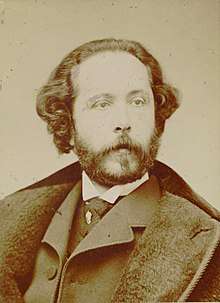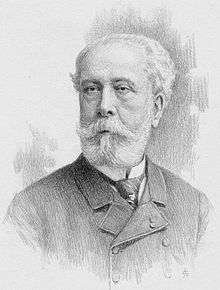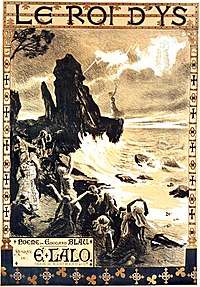Édouard Lalo
Édouard-Victoire-Antoine Lalo (27 January 1823 – 22 April 1892) was a French composer. His most celebrated piece is easily Symphonie espagnole, which consists of five movements and remains a popular work in the standard repertoire for violin and orchestra.


(engraving by Richard Paraire)
Biography
Lalo was born in Lille (Nord), in the northernmost part of France. He attended that city's conservatoire in his youth. Beginning at age 16, he studied at the Paris Conservatoire under François Antoine Habeneck. Habeneck conducted student concerts at the Conservatoire from 1806 and became the founding conductor of the Orchestre de la Société des Concerts du Conservatoire in 1828.
For several years, Lalo worked as a string player and teacher in Paris. In 1848, he joined with friends to found the Armingaud Quartet, in which he played the viola and later second violin. His earliest surviving compositions are songs and chamber works (two early symphonies were destroyed).
Lalo and Julie Besnier de Maligny, a contralto from Brittany, married in 1865. She aroused Lalo's early interest in opera and led him to compose works for the stage, of which Le Roi d'Ys is the most notable. These works were never really popular, despite their originality, and incurred considerable criticism for being allegedly too progressive and Wagnerian. This led Lalo to dedicate most of his career to the composition of chamber music, which was gradually coming into vogue in France, as well as works for orchestra.
Although Lalo is not one of the most recognized names in French music, his distinctive style has earned him a degree of popularity. Symphonie espagnole for violin and orchestra still enjoys a prominent place in the repertoire of violinists, and every now and then his Cello Concerto in D minor is revived. His Symphony in G minor was a favourite of Sir Thomas Beecham (who recorded it) and it has occasionally been championed by later conductors.
Lalo's idiom is notable for strong melodies and colourful orchestration, with a rather Germanic solidity which distinguishes him from other French composers of his era. Such works as the Scherzo in D minor, one of his most colourful pieces, might be considered appropriate embodiments of his distinctive style and strong expressive bent.

The aforementioned Le Roi d'Ys, an opera based on the Breton legend of Ys, is Lalo's most complex and ambitious creation. (This same legend inspired Claude Debussy to compose his famous piano piece, La cathédrale engloutie.) Lalo became a member of the Legion of Honour in 1873. For many years though, Le Roi d'Ys was not considered performable, and was not staged until 1888, when Lalo was 65 years old. He died in Paris in 1892, leaving several unfinished works, including his opera La jacquerie, completed by Arthur Coquard. He was interred at the Père Lachaise Cemetery.
Lalo's son Pierre (6 September 1866 – 9 June 1943) was a music critic who wrote for Le Temps and other French periodicals from 1898 until his death.
Compositions
References in modern culture
In 1962, composer Maurice Jarre used a theme from Lalo's Piano Concerto for the exotic score to Lawrence of Arabia.
The American science fiction television series, Star Trek: The Next Generation, makes reference to a "U.S.S. Lalo" in two different episodes, "We'll Always Have Paris" and "The Best of Both Worlds", though the reference may be to the French composer and/or to the eminent Argentine-American television and film music composer, Lalo Schifrin.
Part of Lalo's Cello Concerto in D minor was used in the second season of Mozart in the Jungle.
References
- Huebner, Steven (2006). French Opera at the Fin de Siècle: Édouard Lalo, Wagnerian. Oxford Univ. Press, US. pp. 231–254. ISBN 978-0-19-518954-4.
- Macdonald, Hugh (1998), "Lalo, Edouard-Victoire-Antoine", in Stanley Sadie, (Ed.), The New Grove Dictionary of Opera, Vol. Two. London: Macmillan Publishers, Inc. ISBN 0-333-73432-7 ISBN 1-56159-228-5
External links
| Wikimedia Commons has media related to Édouard Lalo. |
- Édouard Lalo at the Encyclopædia Britannica
- Lalo Piano Trio Nos. 1-3 sound-bites and discussion of works
- Free scores by Édouard Lalo at the International Music Score Library Project (IMSLP)
- The Mutopia Project has compositions by Édouard Lalo
- . Encyclopædia Britannica (11th ed.). 1911.